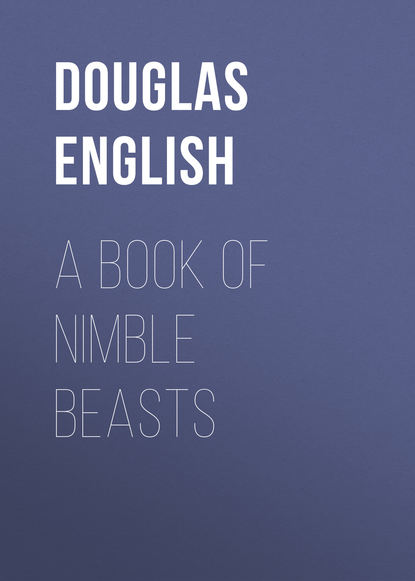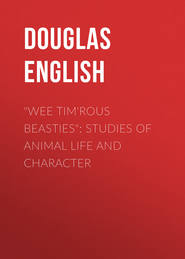По всем вопросам обращайтесь на: info@litportal.ru
(©) 2003-2024.
✖
A Book of Nimble Beasts
Настройки чтения
Размер шрифта
Высота строк
Поля
At the bottom of the picture you will see one of Crabro's stores of blue-bottles, and if you look carefully you will see one of the fly's wings stretching out of it
Last autumn a dangerous bough had to be taken down from the top of a high elm-tree in my garden. It was perhaps sixty feet above the ground and it came down with a crash and broke up into little pieces. I picked up one of these tubes and galleries, which I knew were insects' work. But there was something much more exciting than this. A number of the galleries had blind ends to them, and at the bottom of these were masses of dead blue-bottles, tightly packed, which rested on small pillows of sawdust, and had long plugs of sawdust above them.
This is what the piece of elm-bough looked like. You will be able to see the little tunnels, and the stores of blue-bottles, which are black-looking, and the plugs of sawdust, in which the pupa cases of the wasp-grubs are hidden. You can see one pupa about half way up
I opened one of the long sawdust plugs and found, as I half expected to find, that at the end of it next to the blue-bottles, was a small brown papery cocoon, and that inside the cocoon was a wasp grub. I need hardly tell you that I collected a lot of the wood, and kept it carefully through the winter, and tried to make the little grubs as much at home as if they had stayed up in their tree. To do this I had to keep the wood in moist and rather dark surroundings. Then when the spring came round I sometimes put the wood in the sunshine, when it was not too hot, and in the first week in June I was rewarded for my trouble, for the little wasps hatched out in dozens, and so I was able to find out what they were.
Look up to the top of the trees some warm summer day, and think of the blue-bottle hunt which may be going on above us, and of the wonderful little hunter, Crabro.
This is one of the cocoons of Crabro in the elm-bough. Crabro is just going to hatch out. You can see the little black hole where she has started gnawing
SPINIPES THE SAND-WASP
(MIDSUMMER DAY)
AUTHOR'S NOTE
THIS insect-tale is based on observations of fact extending over several summers. It may interest some of my readers to know the scientific names of the chief characters mentioned. I do not think that any of them have popular names. The heroine is the solitary Sand-Wasp Odynerus Spinipes, a blacker and somewhat smaller insect than the familiar yellow Wasps of Town and Garden. The Red King and the Black Queen are the male and female of a solitary Bumble Bee, Anthophora Pilipes. The Mistress of the Robes is a "Cuckoo" Bee, Melecta armata, which attends on Anthophora, and lays its eggs in the cells made by Anthophora for her own eggs. The grubs of both feed on the honey and pollen which Anthophora alone has the trouble of procuring. O. Spinipes has several cuckoos, the most officious being the jewel flies, Chrysis ignita and Chrysis bidentata, whose grubs, I fancy, eat the grub of Spinipes, as well as the food stored up for it. The Ophion is a common Ichneumon fly, and the beetle-grubs belong to a very common and destructive weevil, Hypera variabilis.
THE Sand Cliff splits the old gravel-pit in two, and, jutting southward, fronts the mid-day sun. The cuttings driven east and west of it have long been clothed with furze and briar and nettle. Rank grass conceals the cart-track round its base, and, on its summit, a thin, root-bound soil gives foothold to a straggling hedge of privet.
THE SAND CLIFF SPLITS THE OLD GRAVEL-PIT IN TWO
Man, needing gravel only, scorned the sand; and, as he turned his back on it, came Nature, gently mothering; and brought it warmth, and light, and life.
First the Wild Bees, Red Kings, Black Queens
First the wild Bees, Red Kings, Black Queens, fringe-footed, shaggy-coated. These made a chambered palace of the cliff, and peopled it within a summer. With them came Lords-in-Waiting and their Ladies, in liveries of black velvet, ermine-faced; and, after these, a fluttering gauze-winged host—jewel-flies ablaze with green and blue and crimson, trim slender-waisted digger-wasps, long-streamered swart ichneumons. And, last of all, came Spinipes herself.
Straight from the blue she dropped on May's last morning, swerved through the hum and racket of the Bees, poised with her smoke-grey wings a-whir, and lighted softly on the centre ledge, her ebony body mirroring the sun, her five gold girdles blazing.
Down dropped a Red King at her side. He stared at her right royally, and kept right royal silence, yet there was kindness in his yellow face, and kindness in the purr of his departure.
Down dropped a Black Queen in his place, and danced and hummed about her, and measured her slim-waistedness, and buzzed her disapproval.—"What is it?" asked she snappishly. "Why does it come in this get-up? Where has it left its furs?"
Down dropped a Red King at her side. He stared at her right royally
"It never had furs," said a voice behind her. It was her Mistress of the Robes.
"I know the family, Ma'am. Queer clothes, of course. But artists, Ma'am, artists to the toe-tips."
"Artists in what?" said the Black Queen.
"In Sand, Ma'am, in Sand. See, she's starting now."
"That's hive-bee's work," said the Black Queen contemptuously.
"The art comes at the finish, Ma'am–"
"Well, call me when it comes," said the Black Queen, "and keep her off the nurseries, and clean that eleventh cell of mine, and wait till I come back. She soared up skywards, fussily, cleared the cliff's head, circled three times about, and set a straight course south.
"Good riddance!" said the Mistress of the Robes.
"They're like that everywhere," said Spinipes. "What are her nurseries to me? Black Queens and black sand go together. Now this is red sand. I feel the grip and bind of it."
In Sand, Ma'am, in Sand. See, she's starting now
She was quite right. The ledge was rain-washed silt. Sunshine had bleached the outer crust of it, but, under this, its substance was brick-red—fine ground stuff too, damp, clingy, easily tunnelled, and easily smarmed into a hold-fast mortar.
"In that case," said the Mistress of the Robes, "I may as well be going."
Slowly she floated off the ledge, yet kept her face towards it. Slowly she tacked from side to side, in dipping, widening sweeps. Slowly she passed the cliff's east edge, and disappeared.
Then Spinipes commenced to dig in earnest.
"Well, call me when it comes," said the Black Queen
Her scissor-jaws worked viciously, carved four-square pellets from the sun-baked crust, gripped them and flung them backwards. As she engaged the softer soil, she added feverish foot-work, and scraped, and rasped, and scrabbled it, and kicked it back in dust-clouds. Her head was quickly buried, next her waist, and, presently, she disappeared completely.
But not for long.
She backed up to the surface, dragging a sand-load underneath her body. She shook this clear, and, without resting, dived afresh. Ten loads in all she raised, and each one meant a longer spell below. For she had more to do than dig. From end to end her shaft must needs be glazed—and this meant patient mouth-work, deft steadying touches as the mortar set, and skill to keep her tube's round symmetry, and guide it in a gentle curve to end in quiet darkness. Three inches down she sank, and, at the bottom, drove a slant, and hollowed out a store-room.
With this the first stage ended. She left her shaft, and, poising in mid-air, made survey of the ledge. To right she swerved, to left again, outwards and back, upwards and down, until its bearings east and west, from sky above, and earth below, were rooted in her memory.
Then Spinipes commenced to dig in earnest
So far, so good—her morning's work was done, the picture of it fixed into her mind. Upwards she soared until the receding cliff shrunk to a splotch of brown. Once more she took her bearings and was satisfied, set her course east, and, with a dropping arrow's flight, came to the hill-top coppice. She landed on the bramble hedge which skirts its western clearing.
"Good hunting, sister!" said the Ophion Fly. She sat on a high briar-leaf, her rainbow wings uplifted.
"It's hardly time for that," said Spinipes. "To-morrow, p'raps. To-day I feed myself."
"There's lucerne on the slope," the Ophion said, "and something underneath you."
"Good hunting, sister!" said the Ophion Fly
There was a snap and flicker in the grass, and presently appeared a pygmy beetle, long-snouted, dusty-coated, trailing its slow legs wearily.
"D'you see it?" said the Ophion Fly.
"I see it, but what of it?"
"It means good hunting, sister. Green grubs, black-headed, fatted. Too small for me, but just the size for you. You'll find them in the lucerne."
"Thank you," said Spinipes, but she was half across the field, a dancing, filmy wisp of pink, wind-borne.
A meal, and then to work, thought Spinipes. It must be done by sunset. It must. It must.






